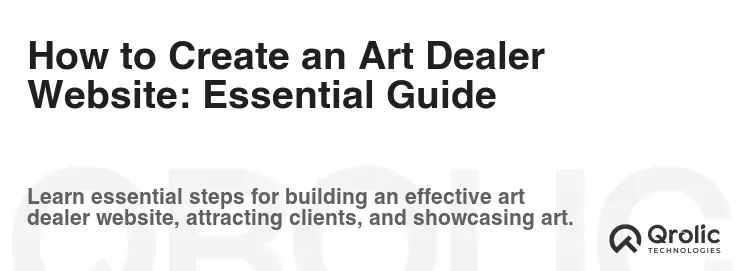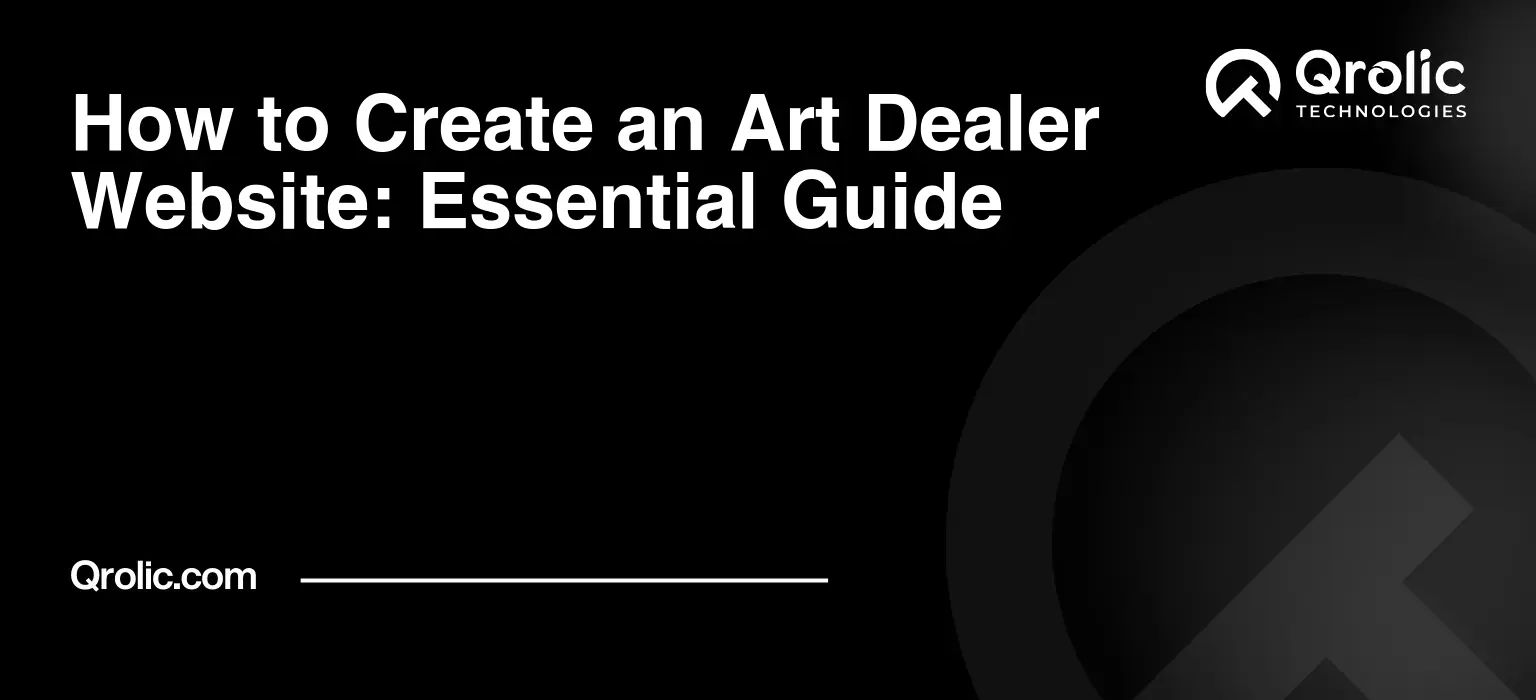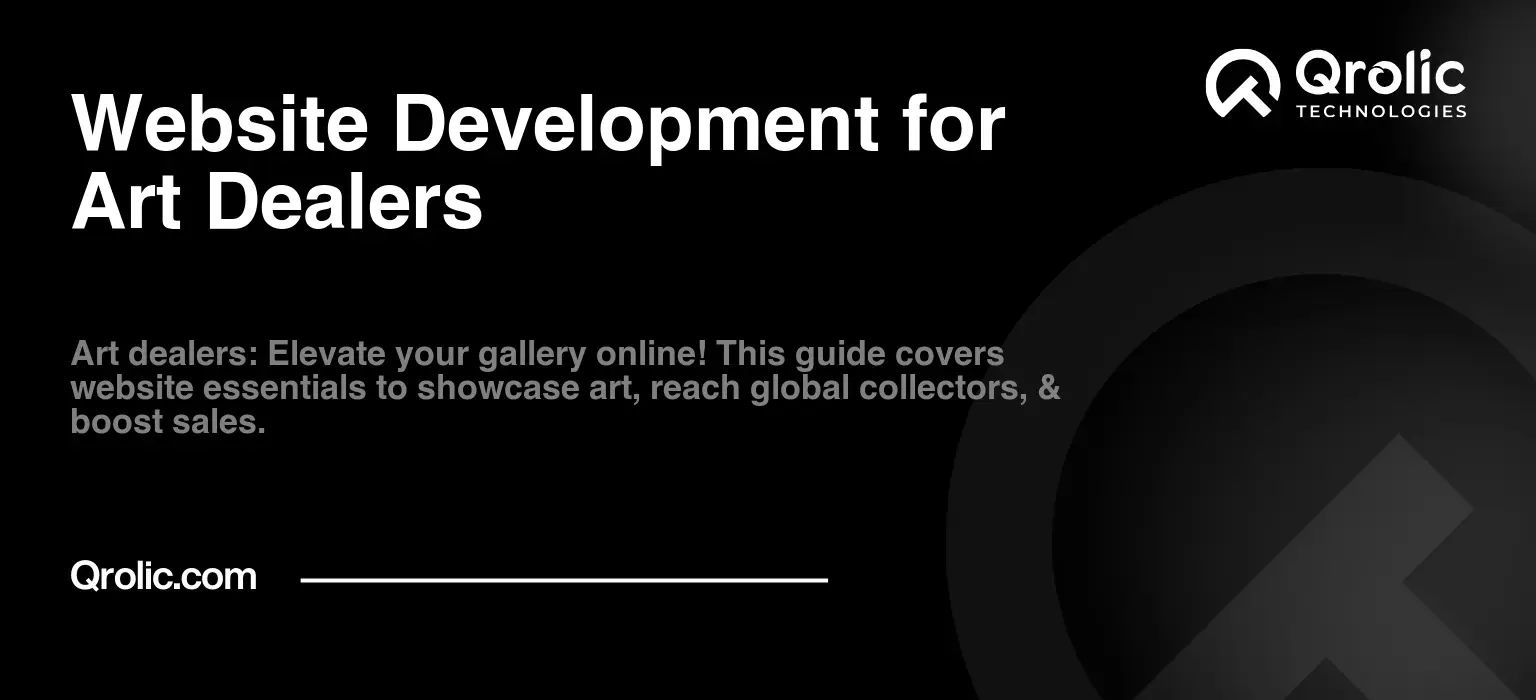Quick Summary:
- Define your website’s purpose, audience, and unique value.
- Design for stunning visuals, easy navigation, and mobile use.
- Showcase artwork with high-quality images and rich descriptions.
- Use SEO, marketing, and analytics to grow online.
Table of Contents
How to Create an Art Dealer Website: Essential Guide

Navigating the Digital Canvas: Why Your Art Dealer Website Matters
The art world, once confined to hushed galleries and exclusive auctions, has exploded onto the digital scene. Today, an online presence isn’t just an option for art dealers; it’s a necessity. But simply having a website isn’t enough. You need a strategically designed, engaging, and user-friendly platform that not only showcases your inventory but also cultivates trust, attracts collectors, and ultimately drives art sales. This essential guide delves deep into the art dealer website creation process, providing actionable strategies and insights to transform your online presence into a thriving virtual gallery.
I. Laying the Foundation: Defining Your Art Dealer Website’s Purpose and Audience
Before diving into design and development, you must clarify the core purpose and target audience of your art dealer website. This foundational step will inform every decision you make, from content strategy to design aesthetics.
A. Identifying Your Goals: What Do You Want to Achieve?
What specific outcomes do you desire from your art dealer website? Be precise and measurable. Common goals include:
- Generating Leads: Capture contact information from potential buyers and sellers.
- Driving Online Sales: Facilitate direct art sales through e-commerce functionality.
- Building Brand Awareness: Establish your gallery’s reputation and expertise.
- Promoting Exhibitions and Events: Increase attendance and engagement.
- Expanding Your Reach: Connect with collectors beyond your geographical location.
- Establishing Thought Leadership: Position yourself as an authority in the art world.
B. Understanding Your Audience: Who Are You Trying to Reach?
Knowing your target audience is crucial for tailoring your website’s content, design, and user experience. Consider the following factors:
- Demographics: Age, location, income level, education.
- Art Preferences: Style, medium, artists they collect, price range.
- Online Behavior: How they search for art, what platforms they use, their level of online sophistication.
- Motivations: What drives them to collect art (investment, aesthetics, status).
C. Defining Your Unique Selling Proposition (USP): What Makes You Different?
In a competitive art market, it’s essential to highlight what makes your gallery unique. Art dealers possess a unique selling proposition. What distinctive qualities, services, or specializations do you offer that set you apart? Examples include:
- Specialization in a specific art movement or style.
- Exclusive representation of emerging artists.
- Offering art advisory services.
- Providing art investment guidance.
- Curating unique and thought-provoking exhibitions.
- Focusing on a particular geographical region’s art.
II. Choosing the Right Platform: Website Builders vs. Custom Development
The next crucial decision is selecting the right platform for building your art dealer website. You have two primary options: website builders and custom development.
A. Website Builders: User-Friendly and Cost-Effective (For Beginners)
Website builders like Squarespace, Wix, and Weebly offer drag-and-drop interfaces, pre-designed templates, and integrated features, making them an attractive option for those with limited technical skills or budget.
-
Pros:
- Ease of Use: No coding required, intuitive interface.
- Affordability: Lower upfront costs and monthly subscription fees.
- Pre-designed Templates: Professional-looking designs to choose from.
- Integrated Features: E-commerce, blogging, and marketing tools included.
- Quick Launch: Get your website up and running quickly.
-
Cons:
- Limited Customization: Less control over design and functionality.
- Scalability Issues: May not be suitable for high-volume traffic or complex features.
- Vendor Lock-in: Difficult to migrate your website to another platform.
- SEO Limitations: Can be less optimized for search engines than custom websites.
- Reliance on the Platform: Subject to the platform’s updates, terms of service, and potential downtime.
B. Custom Development: Maximum Control and Scalability (For Established Art Dealers)
Custom development involves hiring a web developer or agency to build your website from scratch. This option offers unparalleled flexibility and control over design, functionality, and scalability.
-
Pros:
- Complete Customization: Design a unique website that perfectly reflects your brand.
- Scalability: Handle high traffic and complex features as your business grows.
- SEO Optimization: Built with SEO best practices in mind.
- Integration with Existing Systems: Seamlessly integrate with your CRM, inventory management, and other tools.
- Ownership of Code: You own the code, giving you complete control over your website’s future.
-
Cons:
- Higher Cost: Significant upfront investment and ongoing maintenance fees.
- Longer Development Time: Can take weeks or months to complete.
- Technical Expertise Required: Requires hiring experienced developers and designers.
- Ongoing Maintenance: Regular updates and security patches are necessary.
C. Weighing the Options: Which Platform is Right for You?
Consider the following factors when choosing between a website builder and custom development:
- Budget: How much are you willing to invest in your website?
- Technical Skills: Do you have the skills to manage a custom website?
- Timeframe: How quickly do you need your website launched?
- Scalability: How much do you expect your business to grow in the future?
- Customization Needs: How important is it to have a unique and highly customized website?
III. Designing an Art Dealer Website That Captivates and Converts
The design of your art dealer website is crucial for creating a positive first impression, engaging visitors, and ultimately driving art sales.
A. Aesthetic Considerations: Creating a Visual Masterpiece
- Clean and Minimalist Design: Let the art take center stage. Avoid clutter and distractions.
- High-Quality Images: Showcase your artwork with professional, high-resolution images.
- Consistent Branding: Use your gallery’s logo, colors, and typography consistently throughout the website.
- Responsive Design: Ensure your website looks great on all devices (desktops, tablets, and smartphones).
- Art-Focused Color Palette: Neutral backgrounds and subtle accent colors that complement the artwork.
B. User Experience (UX): Guiding Visitors Seamlessly
- Intuitive Navigation: Make it easy for visitors to find what they’re looking for.
- Clear Call-to-Actions: Guide visitors towards desired actions, such as contacting you, viewing artwork details, or making a purchase.
- Fast Loading Speed: Optimize images and code to ensure your website loads quickly.
- Mobile-First Approach: Design for mobile devices first, as a significant portion of your traffic will come from mobile users.
- Accessibility: Ensure your website is accessible to users with disabilities.
C. Essential Pages and Content: Building a Comprehensive Online Gallery
- Homepage: A visually appealing introduction to your gallery, showcasing your featured artists and exhibitions.
- Artwork Listings: Detailed information about each artwork, including title, artist, medium, dimensions, price (if applicable), and provenance.
- Artist Profiles: Biographies and background information on the artists you represent.
- Exhibitions: Information about current and past exhibitions, including dates, featured artists, and images.
- About Us: Your gallery’s history, mission, and team.
- Contact Us: Contact information, including phone number, email address, and physical address.
- Blog: Share insights about the art world, artist interviews, and gallery news.
- Privacy Policy: A statement outlining how you collect, use, and protect user data.
IV. Showcasing Your Artwork: High-Quality Images and Detailed Descriptions
Your art dealer website’s primary purpose is to showcase your artwork. Therefore, presenting your inventory in the best possible light is critical.
A. Photography Best Practices: Capturing the Essence of the Art
- Professional Photography: Invest in professional photographers to capture high-quality images of your artwork.
- Proper Lighting: Use consistent and even lighting to avoid shadows and distortions.
- Multiple Angles: Capture images from different angles to showcase the artwork’s details.
- Detail Shots: Include close-up shots to highlight the texture and brushstrokes.
- Contextual Images: Show the artwork in a room setting to help viewers visualize it in their own homes.
B. Writing Compelling Descriptions: Engaging the Viewer’s Imagination
- Descriptive Language: Use vivid and evocative language to describe the artwork’s aesthetics, subject matter, and historical context.
- Artist’s Intent: Explain the artist’s inspiration, process, and intended message.
- Provenance: Provide information about the artwork’s ownership history and previous exhibitions.
- Technical Details: Include the artwork’s medium, dimensions, and date of creation.
- Emotional Connection: Connect with the viewer’s emotions by highlighting the artwork’s unique qualities and potential impact.
C. Organizing and Categorizing Your Inventory: Making it Easy to Find Art
- Categories and Filters: Use categories and filters to allow visitors to easily browse your inventory by artist, style, medium, price, and other criteria.
- Search Functionality: Implement a robust search function that allows visitors to search for specific artworks or artists.
- Sorting Options: Allow visitors to sort artwork by price, date, or popularity.
- Tags: Use tags to categorize artwork by subject matter, keywords, and themes.
V. E-commerce Functionality: Selling Art Online (If Applicable)
If you plan to sell art directly from your website, you’ll need to implement e-commerce functionality.
A. Choosing an E-commerce Platform: Integrating with Your Website
- Shopify: A popular e-commerce platform that integrates seamlessly with various website builders and offers a wide range of features.
- WooCommerce: A wordpress plugin that transforms your website into an online store.
- BigCommerce: A scalable e-commerce platform designed for larger businesses.
B. Payment Gateway Integration: Secure and Reliable Transactions
- Stripe: A popular payment gateway that offers secure and reliable payment processing.
- PayPal: A widely used payment platform that provides buyer and seller protection.
- Authorize.net: A secure payment gateway that integrates with various e-commerce platforms.
C. Shipping and Handling: Delivering Art Safely
- Professional Packaging: Use professional packaging materials to protect the artwork during shipping.
- Insurance: Insure the artwork for its full value to cover any potential damage or loss during transit.
- Shipping Carriers: Partner with reputable shipping carriers that specialize in handling fine art.
- Tracking: Provide customers with tracking information so they can monitor the shipment’s progress.
VI. Search Engine Optimization (SEO): Making Your Website Discoverable
SEO is crucial for driving traffic to your art dealer website. By optimizing your website for search engines, you can increase its visibility and attract potential customers.
A. Keyword Research: Identifying Relevant Search Terms
- Art-Related Keywords: Research keywords related to art, artists, styles, and movements.
- Location-Based Keywords: Include keywords related to your gallery’s location.
- Long-Tail Keywords: Target longer, more specific search terms that have less competition.
- Competitor Analysis: Analyze your competitors’ websites to identify their top-performing keywords.
B. On-Page Optimization: Optimizing Your Website’s Content
- Title Tags: Use relevant keywords in your page titles.
- Meta Descriptions: Write compelling meta descriptions that entice users to click on your website in search results.
- Header Tags (H1, H2, H3): Use header tags to structure your content and incorporate keywords.
- Image Alt Text: Add descriptive alt text to your images, including relevant keywords.
- Content Optimization: Create high-quality, informative content that is optimized for your target keywords.
C. Off-Page Optimization: Building Authority and Backlinks
- Link Building: Acquire backlinks from other reputable websites in the art world.
- Social Media Marketing: Promote your website and content on social media platforms.
- Online Directories: List your website in online directories related to art and galleries.
- Guest Blogging: Contribute guest posts to other art-related websites and blogs.
VII. Marketing and Promotion: Driving Traffic and Generating Leads
Once your website is live, you need to actively market and promote it to drive traffic and generate leads.
A. Social Media Marketing: Engaging with Your Audience
- Platform Selection: Choose the social media platforms that are most relevant to your target audience.
- Content Strategy: Create engaging content that showcases your artwork, artists, and exhibitions.
- Community Engagement: Interact with your followers and build relationships.
- Paid Advertising: Use paid advertising to reach a wider audience.
B. Email Marketing: Nurturing Leads and Promoting Events
- Email List Building: Collect email addresses from website visitors and gallery attendees.
- Segmentation: Segment your email list based on interests and demographics.
- Email Campaigns: Send targeted email campaigns to promote exhibitions, new artwork, and special events.
- Newsletters: Send regular newsletters to keep your subscribers informed about your gallery’s activities.
C. Content Marketing: Providing Valuable Information and Expertise
- Blog Posts: Create informative and engaging blog posts about art history, artist interviews, and gallery news.
- Ebooks and Guides: Offer free ebooks and guides on topics related to art collecting and investing.
- Webinars and Online Workshops: Host webinars and online workshops to share your expertise and engage with your audience.
VIII. Analytics and Reporting: Measuring Your Website’s Performance
Tracking your website’s performance is essential for identifying areas for improvement and optimizing your marketing efforts.
A. Google Analytics: Tracking Website Traffic and User Behavior
- Website Traffic: Track the number of visitors to your website.
- Bounce Rate: Monitor the percentage of visitors who leave your website after viewing only one page.
- Time on Site: Measure the average amount of time visitors spend on your website.
- Conversion Rate: Track the percentage of visitors who complete a desired action, such as contacting you or making a purchase.
B. Reporting and Analysis: Identifying Trends and Insights
- Regular Reporting: Generate regular reports on your website’s performance.
- Trend Analysis: Identify trends in your website traffic and user behavior.
- A/B Testing: Conduct A/B tests to optimize your website’s design and content.
- Data-Driven Decisions: Use data to inform your website’s strategy and marketing efforts.
IX. Maintaining and Updating Your Website: Keeping it Fresh and Relevant
Your art dealer website is not a one-time project; it requires ongoing maintenance and updates to keep it fresh and relevant.
A. Regular Content Updates: Adding New Artwork and Exhibitions
- New Artwork: Regularly update your website with new artwork from your represented artists.
- Exhibition Updates: Promote upcoming exhibitions and add information about past exhibitions.
- Blog Posts: Publish new blog posts on a regular basis to keep your content fresh and engaging.
B. Security Updates: Protecting Your Website from Threats
- Software Updates: Keep your website’s software and plugins up to date.
- Security Audits: Conduct regular security audits to identify and address vulnerabilities.
- SSL Certificate: Ensure your website has an SSL certificate to encrypt data transmission.
C. Website Backups: Ensuring Data Recovery
- Regular Backups: Back up your website regularly to protect against data loss.
- Offsite Storage: Store your backups in a secure offsite location.
- Disaster Recovery Plan: Develop a disaster recovery plan to ensure you can quickly restore your website in the event of a failure.
X. Art Sales Design with Qrolic Technologies: Partnering for Success
Creating a successful art dealer website requires expertise in Web Development, design, and marketing. Partnering with a technology company like Qrolic Technologies can provide you with the resources and support you need to achieve your online goals.
Qrolic Technologies (https://qrolic.com/) offers a range of services tailored to the art world, including:
- Custom Website Design and Development: Creating bespoke websites that reflect your gallery’s unique brand and style.
- E-commerce Solutions: Building secure and scalable e-commerce platforms for selling art online.
- SEO Optimization: Improving your website’s visibility in search engines.
- Digital Marketing: Driving traffic and generating leads through social media, email marketing, and content marketing.
- Website Maintenance and Support: Providing ongoing maintenance and support to ensure your website is always up-to-date and secure.
Qrolic Technologies understands the unique challenges and opportunities of the art market and can help you create an art dealer website that stands out from the crowd. By partnering with Qrolic, you can focus on what you do best: curating and selling art.
Conclusion: Embracing the Digital Art World
Creating a successful art dealer website is an ongoing process that requires careful planning, execution, and maintenance. By following the strategies and tips outlined in this essential guide, you can create a website that attracts collectors, drives art sales, and establishes your gallery as a leader in the digital art world. Embrace the power of the internet and unlock the potential of your art business with a strategically designed and expertly managed online presence.







